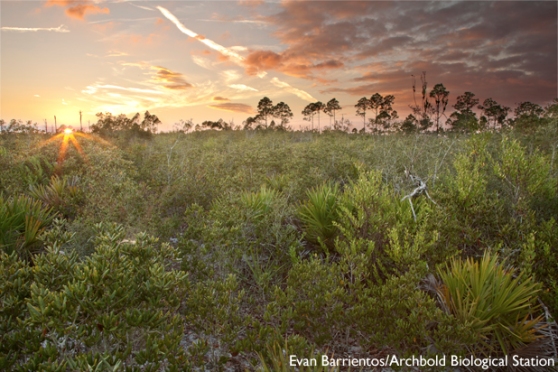My most memorable moment as an intern at Archbold came as a complete surprise one morning. I was walking to the Learning Center, like I did every day, but this morning there was something very very different. On the ground, not even a foot away from the sidewalk, was a large adult Eastern Indigo Snake. This is one of the hardest animals to find at Archbold, and it was also one of the species that I had most wanted to see. I had spent two months hiking around Archbold without seeing one and all of a sudden there’s one greeting me on my way to work! It was possibly the most special animal I’d ever met, and here’s why:

When I was in fourth grade, my science teacher assigned my class to write reports on an endangered species. He wrote down names of endangered animals on pieces of paper and put them in a hat. We each took turns picking the species that we would write our reports about, and when I unfolded my piece of paper I saw the words “Eastern Indigo Snake.” Even in fourth grade I loved animals, but I had never heard of an Eastern Indigo Snake. Well, that was because I grew up in Wisconsin, hundreds of miles north of where they live. I wrote my report, never thinking I would ever actually see one, but I never forgot the name Eastern Indigo Snake.

When I found out that I would be working at Archbold, I was really excited to learn that Eastern Indigo Snakes live there, but I knew they were rare, and didn’t really expect to see one. So when I stood there with my mouth open, watching the shiny black eyes of an Eastern Indigo Snake stare back at me, it was a very powerful moment. To me it meant that my childhood dreams of becoming a biologist and traveling the world had in some small way come true.

Eastern Indigo Snake habitat at Archbold Biological Station
But the story gets better. I sprinted to Dr. Betsie Rothermel’s office, head of Archbold’s Herpetology Program (Herpetology is the study of reptiles and amphibians). Because the Eastern Indigo Snakes is a threatened species, she wanted to capture it to see if it had been caught before and to measure it. I could explain how that went, but instead I’ll just show you:
Why did we go through so much trouble to measure him? Well for one, the size of a snake tells us if it is young or old. Finding young snakes is a good sign because it means that the snakes are reproducing, which is important since they are a threatened species. Turns out this snake was 4.5 feet long, while most male indigos caught at Archbold have been about 5 feet. So that means our indigo still has some growing to do! This information comes from 26 years of research on Eastern Indigo Snakes conducted at Archbold Biological Station.

Please, please note, EASTERN INDIGO SNAKES ARE NOT DANGEROUS! They do not have fangs or venom, and as you can see from the video, they are usually very shy. Also, they eat venomous snakes! (Not that venomous snakes are “bad” either) Indigos are threatened, important, and beautiful animals that deserve our respect.

For more information on Eastern Indigo Snakes and Archbold’s research, check out:
- A blog post about catching and tracking an Indigo at Archbold
- This U.S. Fish and Wildlife fact sheet
- The Orianne Society website
Written, photographed, and filmed by Evan Barrientos, Fall 2014 Environmental Education Intern

excellent!
LikeLike